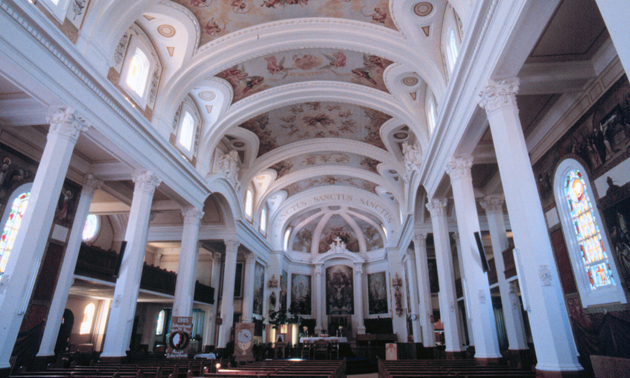See Saskatchewan’s Sistine Chapel in Gravelbourg
Tour the cathedral and museum

What’s in a name? In the town of Gravelbourg, dubbed the Cultural Gem of Saskatchewan, the answer is a whole lot of history.
The town itself is named for its founder, French Canadian priest Father Louis-Pierre Gravel. In the early 20th century, Gravel founded the French Canadian outpost as a way to establish a western presence for French-speaking Canada and the Catholic Church.
But the name on the town sign is not the only one with historical significance. The Centre Culturel Maillard, a community space which pays tribute to Gravelbourg’s French heritage, is named for Monsignor Charles Maillard, one of the thousands of French settlers who answered Gravel’s call.
According to Louis Stringer, curator of the Gravelbourg and District Museum, Maillard was the town’s parish priest from 1917 to 1939, ten years of which he spent painting the walls and ceiling of the lofty church.
“Maillard came here from Northern France in the Lille area,” said Stringer. “He studied art, but he always wanted to become a priest. He came over in 1901 and managed to finish his seminary here in Canada. He more or less convinced the people here in Gravelbourg that they should have a nice big church.”
Stringer said Maillard was “extremely talented” and a “man on a mission,” covering the entire cathedral with four levels of religious art paintings that have stood the test of time and can be viewed by visitors as part of a guided tour of the museum and church.
“The bottom level is a symbolic depiction of the simple condition of man, with the capital sins in large lettering," said Stringer. "There’s a reddish drapery above that symbolizes the blood of Christ, so the painting is of the redemption of man’s sins through the blood of Christ.
"The second level is the way of the cross, the 14 stations. The third level is the story of his favourite saint, Saint Philomena, and the fourth level is the ceiling. It’s just covered with angels. He used models from the community for the angels’ faces.”
Stringer said Maillard managed to paint the ceiling by climbing scaffolds and lying flat on his back with a mirror.
“Like Michelangelo did in the Sistine Chapel, he would paint by reflection,” he said.
Remembering Maillard
Stringer said the Centre Culturel is now named after Maillard to celebrate his devotion and that he is one of the significant people profiled at the museum.
“What we’ve got here at the museum is a bit of his history," said Stringer. "He left works in other places, some in Quebec. We have some photos of paintings he did in other places. We also have a photo of a painting that he did of his mother. He also did sketching, so we have some of those sketches, some of which are in colour. He was trying out different things before he started to paint. And we have his surplice, the gown that he used to celebrate.”
Stringer said that the museum operates from 9 a.m. to 6 p.m. on weekdays and from noon to 6 p.m. on Sunday throughout the summer months. Tours are $10 per person and a group rate is available. The price includes a guided tour of the museum and cathedral and an optional tour of the Gravelbourg convent.
For more information on the Gravelbourg and District Museum, visit its website here. And for a sneak peak of some of Maillard’s work, visit his page on the Gravelbourg Co-Cathedral website.






